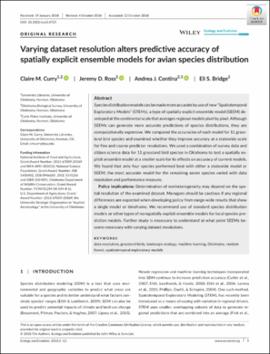| dc.contributor.author | Curry, Claire M. | |
| dc.contributor.author | Ross, Jeremy D. | |
| dc.contributor.author | Contina, Andrea J. | |
| dc.contributor.author | Bridge, Eli S. | |
| dc.date.accessioned | 2018-12-07T18:05:32Z | |
| dc.date.available | 2018-12-07T18:05:32Z | |
| dc.date.issued | 2018-12-06 | |
| dc.identifier.citation | Curry, Claire M., Jeremy D. Ross, Andrea J. Contina, and Eli S. Bridge. “Varying Dataset Resolution Alters Predictive Accuracy of Spatially Explicit Ensemble Models for Avian Species Distribution.” Ecology and Evolution https://doi.org/10.1002/ece3.4725. | en_US |
| dc.identifier.uri | https://hdl.handle.net/11244/316288 | |
| dc.description.abstract | Species distribution models can be made more accurate by use of new “Spatiotemporal Exploratory Models” (STEMs), a type of spatially explicit ensemble model (SEEM) developed at the continental scale that averages regional models pixel by pixel. Although SEEMs can generate more accurate predictions of species distributions, they are computationally expensive. We compared the accuracies of each model for 11 grassland bird species and examined whether they improve accuracy at a statewide scale for fine and coarse predictor resolutions. We used a combination of survey data and citizen science data for 11 grassland bird species in Oklahoma to test a spatially explicit ensemble model at a smaller scale for its effects on accuracy of current models. We found that only four species performed best with either a statewide model or SEEM; the most accurate model for the remaining seven species varied with data resolution and performance measure.
Policy implications: Determination of nonheterogeneity may depend on the spatial resolution of the examined dataset. Managers should be cautious if any regional differences are expected when developing policy from range‐wide results that show a single model or timeframe. We recommend use of standard species distribution models or other types of nonspatially explicit ensemble models for local species prediction models. Further study is necessary to understand at what point SEEMs become necessary with varying dataset resolutions. | en_US |
| dc.description.sponsorship | Article processing charges funded by University of Oklahoma Libraries. This work was funded by U.S. Department of Agriculture (USDA) NIFA grant 2013‐67009‐20369 to ESB and supported by the AWS Cloud Credits for Research program. CMC was supported by National Science Foundation (NSF) grants IDBR 1014891 and ABI 1458402 to ESB and Oklahoma Department of Wildlife Conservation grant F17AF01294 (W‐194‐R‐1) to M.A. Patten. AJC was supported by NSF grants IDBR 1014891, DGE 1545261, and DEB 0946685 and by USDA grant NIFA‐AFRI‐003536. Additional support was provided by the University Strategic Organization in "Applied Aeroecology" at the University of Oklahoma. | en_US |
| dc.language | en_US | en_US |
| dc.rights | Attribution 4.0 International | * |
| dc.rights.uri | https://creativecommons.org/licenses/by/4.0/ | * |
| dc.subject | data resolution | en_US |
| dc.subject | grassland birds | en_US |
| dc.subject | landscape ecology | en_US |
| dc.subject | machine learning | en_US |
| dc.subject | Oklahoma | en_US |
| dc.subject | random forest | en_US |
| dc.subject | spatiotemporal exploratory model | en_US |
| dc.title | Varying dataset resolution alters predictive accuracy of spatially explicit ensemble models for avian species distribution | en_US |
| dc.type | Article | en_US |
| dc.description.peerreview | Yes | en_US |
| dc.identifier.doi | 10.1002/ece3.4725 | en_US |
| ou.group | Other | en_US |

